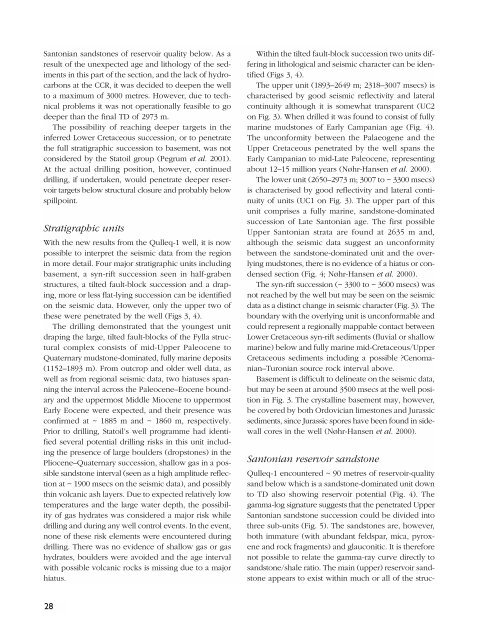The Nalunaq gold prospect, South Greenland - Geus
The Nalunaq gold prospect, South Greenland - Geus
The Nalunaq gold prospect, South Greenland - Geus
Create successful ePaper yourself
Turn your PDF publications into a flip-book with our unique Google optimized e-Paper software.
Santonian sandstones of reservoir quality below. As a<br />
result of the unexpected age and lithology of the sediments<br />
in this part of the section, and the lack of hydrocarbons<br />
at the CCR, it was decided to deepen the well<br />
to a maximum of 3000 metres. However, due to technical<br />
problems it was not operationally feasible to go<br />
deeper than the final TD of 2973 m.<br />
<strong>The</strong> possibility of reaching deeper targets in the<br />
inferred Lower Cretaceous succession, or to penetrate<br />
the full stratigraphic succession to basement, was not<br />
considered by the Statoil group (Pegrum et al. 2001).<br />
At the actual drilling position, however, continued<br />
drilling, if undertaken, would penetrate deeper reservoir<br />
targets below structural closure and probably below<br />
spillpoint.<br />
Stratigraphic units<br />
With the new results from the Qulleq-1 well, it is now<br />
possible to interpret the seismic data from the region<br />
in more detail. Four major stratigraphic units including<br />
basement, a syn-rift succession seen in half-graben<br />
structures, a tilted fault-block succession and a draping,<br />
more or less flat-lying succession can be identified<br />
on the seismic data. However, only the upper two of<br />
these were penetrated by the well (Figs 3, 4).<br />
<strong>The</strong> drilling demonstrated that the youngest unit<br />
draping the large, tilted fault-blocks of the Fylla structural<br />
complex consists of mid-Upper Paleocene to<br />
Quaternary mudstone-dominated, fully marine deposits<br />
(1152–1893 m). From outcrop and older well data, as<br />
well as from regional seismic data, two hiatuses spanning<br />
the interval across the Paleocene–Eocene boundary<br />
and the uppermost Middle Miocene to uppermost<br />
Early Eocene were expected, and their presence was<br />
confirmed at ~ 1885 m and ~ 1860 m, respectively.<br />
Prior to drilling, Statoil’s well programme had identified<br />
several potential drilling risks in this unit including<br />
the presence of large boulders (dropstones) in the<br />
Pliocene–Quaternary succession, shallow gas in a possible<br />
sandstone interval (seen as a high amplitude reflection<br />
at ~ 1900 msecs on the seismic data), and possibly<br />
thin volcanic ash layers. Due to expected relatively low<br />
temperatures and the large water depth, the possibility<br />
of gas hydrates was considered a major risk while<br />
drilling and during any well control events. In the event,<br />
none of these risk elements were encountered during<br />
drilling. <strong>The</strong>re was no evidence of shallow gas or gas<br />
hydrates, boulders were avoided and the age interval<br />
with possible volcanic rocks is missing due to a major<br />
hiatus.<br />
Within the tilted fault-block succession two units differing<br />
in lithological and seismic character can be identified<br />
(Figs 3, 4).<br />
<strong>The</strong> upper unit (1893–2649 m; 2318–3007 msecs) is<br />
characterised by good seismic reflectivity and lateral<br />
continuity although it is somewhat transparent (UC2<br />
on Fig. 3). When drilled it was found to consist of fully<br />
marine mudstones of Early Campanian age (Fig. 4).<br />
<strong>The</strong> unconformity between the Palaeogene and the<br />
Upper Cretaceous penetrated by the well spans the<br />
Early Campanian to mid-Late Paleocene, representing<br />
about 12–15 million years (Nøhr-Hansen et al. 2000).<br />
<strong>The</strong> lower unit (2650–2973 m; 3007 to ~ 3300 msecs)<br />
is characterised by good reflectivity and lateral continuity<br />
of units (UC1 on Fig. 3). <strong>The</strong> upper part of this<br />
unit comprises a fully marine, sandstone-dominated<br />
succession of Late Santonian age. <strong>The</strong> first possible<br />
Upper Santonian strata are found at 2635 m and,<br />
although the seismic data suggest an unconformity<br />
between the sandstone-dominated unit and the overlying<br />
mudstones, there is no evidence of a hiatus or condensed<br />
section (Fig. 4; Nøhr-Hansen et al. 2000).<br />
<strong>The</strong> syn-rift succession (~ 3300 to ~ 3600 msecs) was<br />
not reached by the well but may be seen on the seismic<br />
data as a distinct change in seismic character (Fig. 3). <strong>The</strong><br />
boundary with the overlying unit is unconformable and<br />
could represent a regionally mappable contact between<br />
Lower Cretaceous syn-rift sediments (fluvial or shallow<br />
marine) below and fully marine mid-Cretaceous/Upper<br />
Cretaceous sediments including a possible ?Cenomanian–Turonian<br />
source rock interval above.<br />
Basement is difficult to delineate on the seismic data,<br />
but may be seen at around 3500 msecs at the well position<br />
in Fig. 3. <strong>The</strong> crystalline basement may, however,<br />
be covered by both Ordovician limestones and Jurassic<br />
sediments, since Jurassic spores have been found in sidewall<br />
cores in the well (Nøhr-Hansen et al. 2000).<br />
Santonian reservoir sandstone<br />
Qulleq-1 encountered ~ 90 metres of reservoir-quality<br />
sand below which is a sandstone-dominated unit down<br />
to TD also showing reservoir potential (Fig. 4). <strong>The</strong><br />
gamma-log signature suggests that the penetrated Upper<br />
Santonian sandstone succession could be divided into<br />
three sub-units (Fig. 5). <strong>The</strong> sandstones are, however,<br />
both immature (with abundant feldspar, mica, pyroxene<br />
and rock fragments) and glauconitic. It is therefore<br />
not possible to relate the gamma-ray curve directly to<br />
sandstone/shale ratio. <strong>The</strong> main (upper) reservoir sandstone<br />
appears to exist within much or all of the struc-<br />
28

















